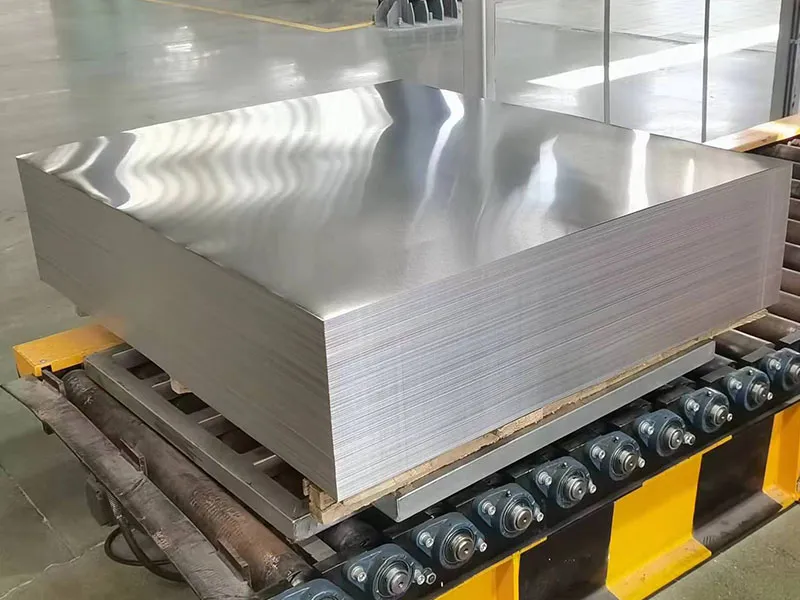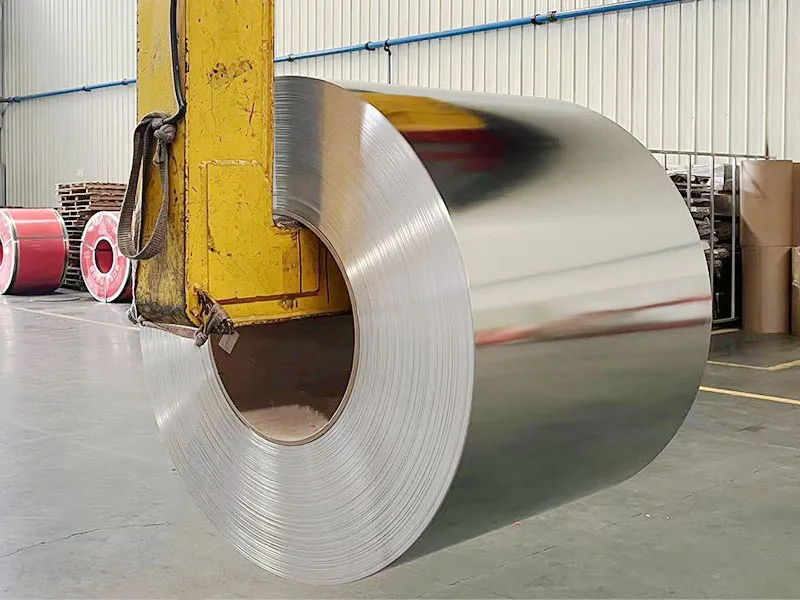As a common and widely used packaging form in modern industrial society, tin can packaging occupies an important position in various products such as food, beverages, cosmetics, and chemicals. Tin can packaging is known for its strength, durability, airtightness, and environmental protection, especially in products that need to be stored for a long time and maintain sealing and quality.
However, when discussing tin can packaging, tinplate sheet often becomes the focus. What exactly is tin can packaging? Is tinplate sheet suitable as the main material for tin cans? This article will explore this issue in detail, explaining the characteristics, process, and adaptability of tinplate sheet for tin can packaging.

What is tin can packaging?
Tin can packaging is a can packaging form made of iron as the main material. In a broad sense, tin cans can include steel cans and tin cans. Common tin can materials are mainly divided into two categories: ordinary steel plates and tinplate sheets.
Material sources of tin can packaging
Iron cans usually use cold-rolled steel plates as the base material, and the production of such steel plates requires a series of industrial processing processes. Cold-rolled steel sheets have high strength, toughness and durability, and are suitable for manufacturing packaging materials that require long-term storage and strong pressure resistance. However, steel sheets alone are not enough to prevent corrosion. Steel sheets are prone to rust when exposed to air and moisture, especially when storing liquids or food. Therefore, in order to improve the anti-corrosion performance of iron cans, it is usually necessary to coat the steel sheets, which involves the use of tinplate sheets.
Features of tin can packaging
The outstanding features of tin can packaging are as follows:
● High strength: The material properties of iron cans give them very good pressure resistance and collision resistance, and can protect the contents from external physical impact during transportation and storage.
● Good airtightness: Iron cans can provide excellent sealing, which is especially important for products such as food and beverages that need to remain fresh or isolate oxygen and moisture. Iron cans can prevent oxygen, moisture and light from entering, extending the shelf life of products.
● Heat and cold resistance: Tin can packaging can withstand higher or lower temperatures, so they can be used in high-temperature sterilization or low-temperature storage environments, suitable for some special production and storage needs.
● Anti-corrosion treatment: Iron cans often need to be tinned or coated to prevent chemical reactions between the steel plate and the contents, avoid product deterioration or affect the taste.
● Environmentally friendly and recyclable: Iron cans are a highly recyclable material. After their service life, they can be recycled and reused to reduce environmental pollution, which makes tin can packaging highly respected in the field of environmental protection.
Common uses of tin can packaging
Tin can packaging is widely used in the packaging of various products, especially those that require long-term storage or have special storage conditions. For example:
● Food cans: From meat, fish, vegetables to canned fruits, tin can packaging is widely used in the food industry due to its sealing and anti-corrosion properties.
● Beverage cans: Liquid foods such as beer, carbonated drinks, and juices are often used in tin can packaging because it can keep the beverage fresh and prevent gases such as carbon dioxide from escaping.
● Cosmetics and chemicals: tin can packaging is also used to store cosmetics such as skin creams and spray products, or chemicals such as paints, lubricants, etc.

What is tinplate sheet?
Tinplate sheet, also known as tin-plated iron, is a specially processed iron material that is widely used in the manufacture of food cans, beverage cans, cosmetic containers, and packaging for various industrial products. It is formed by coating a thin layer of tin film on the surface of cold-rolled low-carbon steel. The thickness of this layer of tin usually ranges from a few microns to tens of microns. The addition of tin is mainly to enhance the corrosion resistance of iron.
Manufacturing process of tinplate sheet
The production process of tinplate sheet usually includes the following steps:
● Selection of steel plate substrate: tinplate sheet usually uses low-carbon cold-rolled steel plate as the substrate. Low-carbon steel has good ductility and processing properties, which facilitates subsequent tinning and forming.
● Tinning process: Tinning is a key link in the production of tinplate sheet. There are two main ways of tinning: electroplating and hot-dip tinning. Electroplating tin is more common because it can control the thickness of the tin layer more evenly and has higher production efficiency. Hot-dip tinning is to immerse the steel plate in molten tin at high temperature for coating.
● Passivation treatment: In order to further improve the anti-corrosion performance, the tinplate sheet after tinning is usually passivated. This step mainly forms an oxide film on the surface of the tin layer by chemical means to further improve its anti-oxidation and corrosion resistance.
● Oil film treatment: In some applications, a layer of oil film is also applied to the surface of the tinplate sheet, mainly to prevent the tin layer from being damaged during storage and processing.
Performance characteristics of tinplate sheet
As a tin-plated material, tinplate sheet has both the strength of steel and the anti-corrosion properties of tin. The following are its main performance characteristics:
● Excellent anti-corrosion performance: The tin-plated layer enables the tinplate sheet to maintain good anti-corrosion performance when in contact with air, moisture and acidic substances, especially suitable for the field of food packaging.
● Smooth and beautiful surface: The tin layer gives the tinplate sheet a smooth and shiny appearance, and is easy to print and paint, so it is very suitable as a high-end packaging material.
● Good processability: tinplate sheet has good ductility and toughness, is easy to process and form, and is suitable for making cans of various shapes.
● Food contact safety: Tin is a food-grade material. Tinplate sheet is widely used in the food packaging industry and meets many international food safety standards.

Is tinplate sheet suitable for tin can packaging?
When discussing tin can packaging, tinplate sheet is often considered one of the best materials, especially in the field of packaging that requires high corrosion resistance, sealing and food safety standards. So, is tinplate sheet suitable for tin can packaging? The answer is yes. Tinplate sheet is particularly suitable for manufacturing various types of tin can packaging due to its unique properties.
Application of tinplate sheet in canned food packaging
The requirements for materials for canned food packaging are extremely strict. First of all, it must have excellent corrosion resistance to prevent chemical reactions between the packaging and the ingredients in the food. Tinplate sheet is an ideal material for canned food packaging because of its excellent anti-corrosion properties. The tin layer on its surface can effectively isolate air and moisture, prevent steel from rusting and corroding, and ensure that food can be stored in cans for a long time. In addition, the presence of the tin layer can also prevent the taste and color of the food from being affected by the can material, ensuring that the food in the can maintains its original flavor and nutrition.
For acidic foods such as tomatoes and pickles, tinplate sheet cans provide excellent acid resistance protection. Moreover, the treated tinplate sheet has good airtightness, which can prevent oxygen from entering the can and extend the shelf life of the food.
Application of tinplate sheet in beverage packaging
Tinplate sheet is also widely used in the manufacture of beverage cans, especially carbonated beverages and beer. Due to the good sealing of tinplate sheet cans, it can effectively keep the carbon dioxide gas of the beverage from escaping, ensuring that the beverage maintains a refreshing taste for a long time. Its anti-corrosion performance can also prevent the chemical reaction between the beverage and the can, ensuring the safety and taste of the beverage.
Processing advantages of tinplate sheet
In addition to its anti-corrosion performance, the processability of tinplate sheet also makes it one of the preferred materials for tin can packaging. Tinplate sheet can be easily processed into cans of various shapes and sizes according to different needs, which has great flexibility in packaging design. At the same time, the tinplate sheet has a smooth surface, which is easy to print and decorate, and can meet the needs of the food and beverage industry for packaging aesthetics and brand display.
Environmental protection and recyclability
Tinplate sheet has good environmental performance. It can not only be reused for a long time, but also be reused through professional recycling processes. With the global attention to environmental issues, the recyclability and recycling rate of tinplate sheet packaging materials have become an important reason for its popularity.

